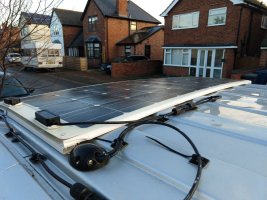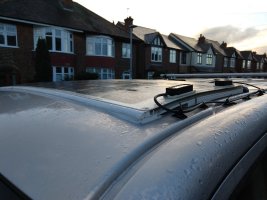Had seen this video and like you I was impressed, would be great, would be great to see how this works out on your T6 (what size panel are you fitting)?I have bought renogy panel. Mailed them to get recommended fitting method. Instructions hinted at need airflow under panel; but not confident their method would give good flow.
I am going to use the polycarbonate method this guy uses...
Looks like a good solution.
You are using an out of date browser. It may not display this or other websites correctly.
You should upgrade or use an alternative browser.
You should upgrade or use an alternative browser.
Another failed solar panel
- Thread starter Salty Spuds
- Start date
-
- Tags
- solar
I’m convinced that the failure of flexi panels is due to the difference in expansion rates between the panel & the roof. Rigid panels in brackets are floating, and can expand & contract independently of the roof.
If that is the case, mounting them on plastic like in the video should solve that problem.I’m convinced that the failure of flexi panels is due to the difference in expansion rates between the panel & the roof. Rigid panels in brackets are floating, and can expand & contract independently of the roof.
Possibly, but all he’s done is created a hybrid rigid panel. By the time you’ve messed around with backing plastic & mounting rails, you’re into rigid panel territory. It’s defeated the object of having a flexible panel in the first place. I.e. (perceived) low profile.If that is the case, mounting them on plastic like in the video should solve that problem.
Just my view obviously.
Good point although maybe the extra height is less than the 40mm than on the rigid panel?Possibly, but all he’s done is created a hybrid rigid panel. By the time you’ve messed around with backing plastic & mounting rails, you’re into rigid panel territory. It’s defeated the object of having a flexible panel in the first place. I.e. (perceived) low profile.
Just my view obviously.
Yes yo need a 3mm gap then no problems been told that from my converter they overheat.He doesn’t use much sikaflex does he.
As previously mentioned I used the fitting method from previous video using a polycarbonate sheet between the renology panel and my roof. I have left open ends of poly sheet cells open and made extra openings in middle of rows to increase airflow.
Been fitted for about 6 months now. See if this one does more than 2 years.
But yes doing this turns a flexible panel into a less flexible panel. But it should help maintain cell efficiency and life. Cell output drops off with temp and thermal shock and differential expansion rates are an issue.
The flexible panels are inherently less reliable than the rigid.
Been fitted for about 6 months now. See if this one does more than 2 years.
But yes doing this turns a flexible panel into a less flexible panel. But it should help maintain cell efficiency and life. Cell output drops off with temp and thermal shock and differential expansion rates are an issue.
The flexible panels are inherently less reliable than the rigid.
Well, when I went for 400w of solar, one failed in the first month.
Went to France in the summer and a further 3 failed on one day of being parked in baking hot sunshine.
So last weekend was an action packed removal process where I bit the bullet to remove all 4 and replace with a different brand with rear entry glands.
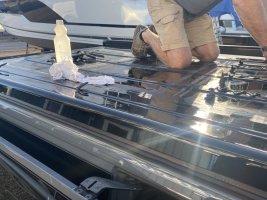
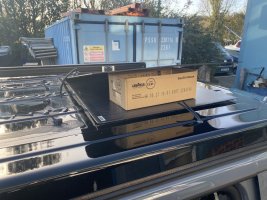
Fingers crossed these more expensive and better quality panels last!
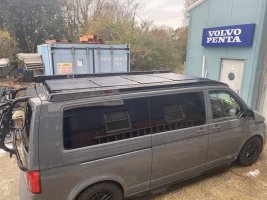
Went to France in the summer and a further 3 failed on one day of being parked in baking hot sunshine.
So last weekend was an action packed removal process where I bit the bullet to remove all 4 and replace with a different brand with rear entry glands.


Fingers crossed these more expensive and better quality panels last!

Last edited:
Interested in which one you bought, as not seen a 400watt version that fits on VW roof?Well, when I went for 400w of solar, one failed in the first month.
Went to France in the summer and a further 3 failed on one day of being parked in baking hot sun!
So last weekend was an action packed removal process where I bit the bullet to remove all 4 and replace with a different brand with rear entry glands.
Fingers crossed these more expensive and better quality panels last!
Interested in which one you bought, as not seen a 400watt version that fits on VW roof?
I edited the post to include a few pictures.
Looks like 4x100w panelsInterested in which one you bought, as not seen a 400watt version that fits on VW roof?
Yes. 3 out of four failed! These are the replacements.Looks like 4x100w panels
Thanks.That looks great and loads of air under panels. Good luck with new fix.
The new panels are PVLogic which are constructed in a 7 layer laminate. The old panels were 5 layers and I'm hoping that the new panels will last.
I wasn't able to 100% manage to get the roof prestine, which I didn't worry about as I was going to seal around the perimeter of the new panels.
This thread makes me think that I will leave the perimeter open, but I now have a nasty sealant stain around each panel:
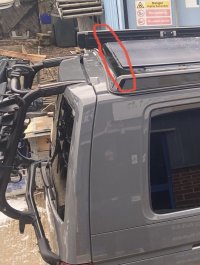
I have left the new panels open as opposed to the originals.
Here is a photo of the originals showing them sealed around the perimeter.
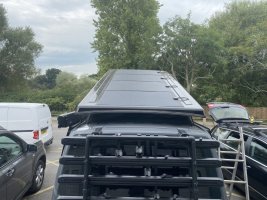
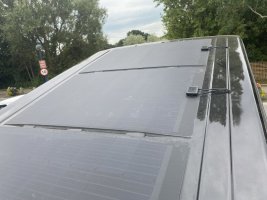
At least the rear glands on the new panels make it look tidier and the new panels are mounted 3-5mm proud of the roof.
I may have a go at that nasty old sealant stain with a caramel wheel when it isn't blooming cold and miserable.
A lot of work. Hope it works out. But i think the conclusion will be that these so called flexible panels are really not fit for purpose and nothing beats the rigid panels for reliability and longevity.Thanks.
The new panels are PVLogic which are constructed in a 7 layer laminate. The old panels were 5 layers and I'm hoping that the new panels will last.
I wasn't able to 100% manage to get the roof prestine, which I didn't worry about as I was going to seal around the perimeter of the new panels.
This thread makes me think that I will leave the perimeter open, but I now have a nasty sealant stain around each panel:
View attachment 180948
I have left the new panels open as opposed to the originals.
Here is a photo of the originals showing them sealed around the perimeter.
View attachment 180946
View attachment 180947
At least the rear glands on the new panels make it look tidier and the new panels are mounted 3-5mm proud of the roof.
I may have a go at that nasty old sealant stain with a caramel wheel when it isn't blooming cold and miserable.
I hope you're wrong.A lot of work. Hope it works out. But i think the conclusion will be that these so called flexible panels are really not fit for purpose and nothing beats the rigid panels for reliability and longevity.
Next time, the holes for the rear exit glands will need making good and if the panels need replacing I will at best need to get the entire roof repainted.
I must be the luckiest "so-called flexible panel" owner in the world, then, as I have got years and years of reliability and longevity from them.A lot of work. Hope it works out. But i think the conclusion will be that these so called flexible panels are really not fit for purpose and nothing beats the rigid panels for reliability and longevity.
That said, there are some points about them:
(a) The lifespan of flexible solar panels is one of their significant downsides.
(b) The rigid solar panels used in home solar installations are exceptionally rugged and come with a twenty-five-year warranty.
(c) In contrast, flexible solar panels typically offer a warranty of between one and three years. This short warranty doesn’t necessarily mean the product won’t last longer than this.
(d) Since most flexible solar panels are designed for use on the go, it is expected that they will undergo more wear and tear than rigid solar panels which usually remain in place.
However, if you have a PET laminated flexible solar panel, you should expect it to last a maximum of around five years. If you go for ETFH laminated panels, then, with care, you can expect them to last somewhere in the region of ten years. (Taken from: literoflightusa.org/flexible-vs-rigid-solar-panels)
Considering there are thousand's of them sold, they must be working fine........ If they were no good, why would the likes of Renogy a very big company sell them? Worth a read:

Rigid vs. Flexible Solar Panels: The Pros & Cons of Different Styles
Check The Pros & Cons of Different Styles Between Rigid Solar Panel and Flexible Solar Panel, Shop best Rigid, Flexible and portable solar panels at Renogy
 www.renogy.com
www.renogy.com
Last edited:
Is ETFE the same as ETFH?If you go for ETFH laminated panels, then, with care, you can expect them to last somewhere in the region of ten years.
Old panels were 2 year warranty. New panels are covered by 5 years.
The marketing blurb from the supplier of the new panels states:
"ETFE has a memory effect or self-healing capacity in the event the panel comes into contact with branches etc, thus ensuring any slight abrasions are ‹healed within a few hours."
It was the heat that killed my old panels. Fingers crossed for a bit of longevity as "branches, etc" we're not my issue.
Typo, but yes I think so.Is ETFE the same as ETFH?
Old panels were 2 year warranty. New panels are covered by 5 years.
The marketing blurb from the supplier of the new panels states:
"ETFE has a memory effect or self-healing capacity in the event the panel comes into contact with branches etc, thus ensuring any slight abrasions are ‹healed within a few hours."
It was the heat that killed my old panels. Fingers crossed for a bit of longevity as "branches, etc" we're not my issue.
Similar threads
- Replies
- 14
- Views
- 1K
- Replies
- 23
- Views
- 2K

